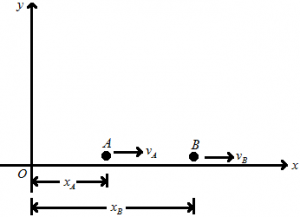Relative Motion in One Dimension
Consider the motion of a car moving towards right and two observers O₁ and O₂ are coming from opposite directions as shown in below figure.

Observer O₁ finds that the car is moving slower while observer O₂ finds that the car is moving faster in comparison to when observer is at rest. The motion of same object looks different for two different observers. To understand such observation, there is need of introduction of the concept of relative velocity.
In the below figure, two particles A and B are moving with velocities vA and vB, accelerations aA and aB, respectively.

If \(\overrightarrow{{{x}_{A}}}\) and \(\overrightarrow{{{x}_{B}}}\) are their respective displacements with respect to fixed origin, then:
1. The relative displacement of B with respect to A is defined as \(\overrightarrow{{{x}_{BA}}}\,\,=\,\,\overrightarrow{{{x}_{B}}}\,\,-\,\,\overrightarrow{{{x}_{A}}}\) … (1),
Differentiating equation (1) with respect to time.
2. The relative velocity of B with respect to A is defined as \(\overrightarrow{{{v}_{BA}}}\,\,=\,\,\overrightarrow{{{v}_{B}}}\,\,-\,\,\overrightarrow{{{v}_{A}}}\) … (2),
Differentiating equation (2) with respect to time.
3. The relative acceleration of B with respect to A is defined as \(\overrightarrow{{{a}_{BA}}}\,\,=\,\,\overrightarrow{{{a}_{B}}}\,\,-\,\,\overrightarrow{{{a}_{A}}}\) … (3).
The equations of motion in one dimension are modified as:
\(\overrightarrow{{{v}_{BA}}}\,\,=\,\,\overrightarrow{{{u}_{BA}}}+\overrightarrow{{{a}_{BA}}}t\,\,\,\,\Rightarrow \,\,\overrightarrow{{{v}_{rel}}}\,\,=\,\,\overrightarrow{{{u}_{rel}}}+\overrightarrow{{{a}_{rel}}}t\).
\(\overrightarrow{{{x}_{BA}}}\,\,=\,\,\overrightarrow{{{u}_{BA}}}t+\frac{1}{2}\overrightarrow{{{a}_{BA}}}{{t}^{2}}\,\,\,\,\Rightarrow \,\,\overrightarrow{{{x}_{rel}}}=\overrightarrow{{{u}_{rel}}}t+\frac{1}{2}\overrightarrow{{{a}_{rel}}}{{t}^{2}}\).
\(v_{rel}^{2}\,\,-\,\,u_{rel}^{2}\,\,=\,\,2{{a}_{rel}}{{x}_{rel}}\).
The relative velocity of a particular A with respect to B is defined as the velocity with which A appears to move if B is considered to be at rest. In other words, it is the velocity with which A appears to move as seen by B considering itself to be at rest.
